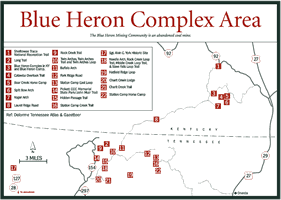
[Fig.
7(14)] Nestled against the western side of the Big South Fork National
River Recreation Area at the Kentucky state line. Pickett is one of the most
botanically diverse parks in the Tennessee State Park system. In the spring
there are many wildflowers, including bluets (Houstonia serpyllifolia),
bloodroot (Sanguinaria canadensis), mayapple (Podophyllum peltatum),
mountain laurel (Kalmia laifolia), Catawba rhododendron (Rhododendron
catawbiense), pinxter flower (Rhododendron nudiflorum), trailing
arbutus (Epigaea repens), and several kinds of violets. In addition,
the park has exceptional scenic and geologic attractions.
The 11,752 acres of land turned over to Tennessee by the Kentucky-based Stearns Coal and Lumber Company in 1933 became a state forest. In 1934, the Civilian Conservation Corps (CCC) and National Park Service aided the state in developing the facilities to make it Tennessee's first state park.
Of particular interest are unusual rock formations, natural bridges and tunnels, caves and rock shelters, waterfalls, lush forests, and the 15-acre, man-made Arch Lake, lined with cliffs and named for the natural bridge located on one of the embayments. Pickett is also the southern terminus of the Sheltowee Trace National Recreation Trail.
Since Pickett is open to all types of hunting in season, safety zones have been established to define the areas closed to hunting.
There are 14 trails from which to choose, all of them interconnecting. Most are less than 2 miles in length and are easy to moderately difficult. All are accessible from near the park office. Two of the longer trails, Hidden Passage Trail and Rock Creek Trail, are especially popular.
[Fig. 7(15)] This is a trail that is popular year-round, since it offers a wide variety of scenic views and seasonal botanical delights. The profusion of spring wildflowers is particularly impressive. The trail is named for a sandstone tunnel through a bluff.
Features along the trail are evergreen and deciduous forests, wildflowers, waterfalls, large rock shelters, Thompson Creek, Rock Creek, wildlife, and scenic views. A side trail leads to an abandoned railroad tunnel, but park rangers say it is not safe to enter.
[Fig. 7(9)] Interesting features along this route include streams, waterfalls, deciduous and evergreen forests, and rock bluffs. Much of Rock Creek Trail follows an old railroad bed and there are a couple of good camping spots before it reaches a parking area and more primitive camping spots near TN 154.